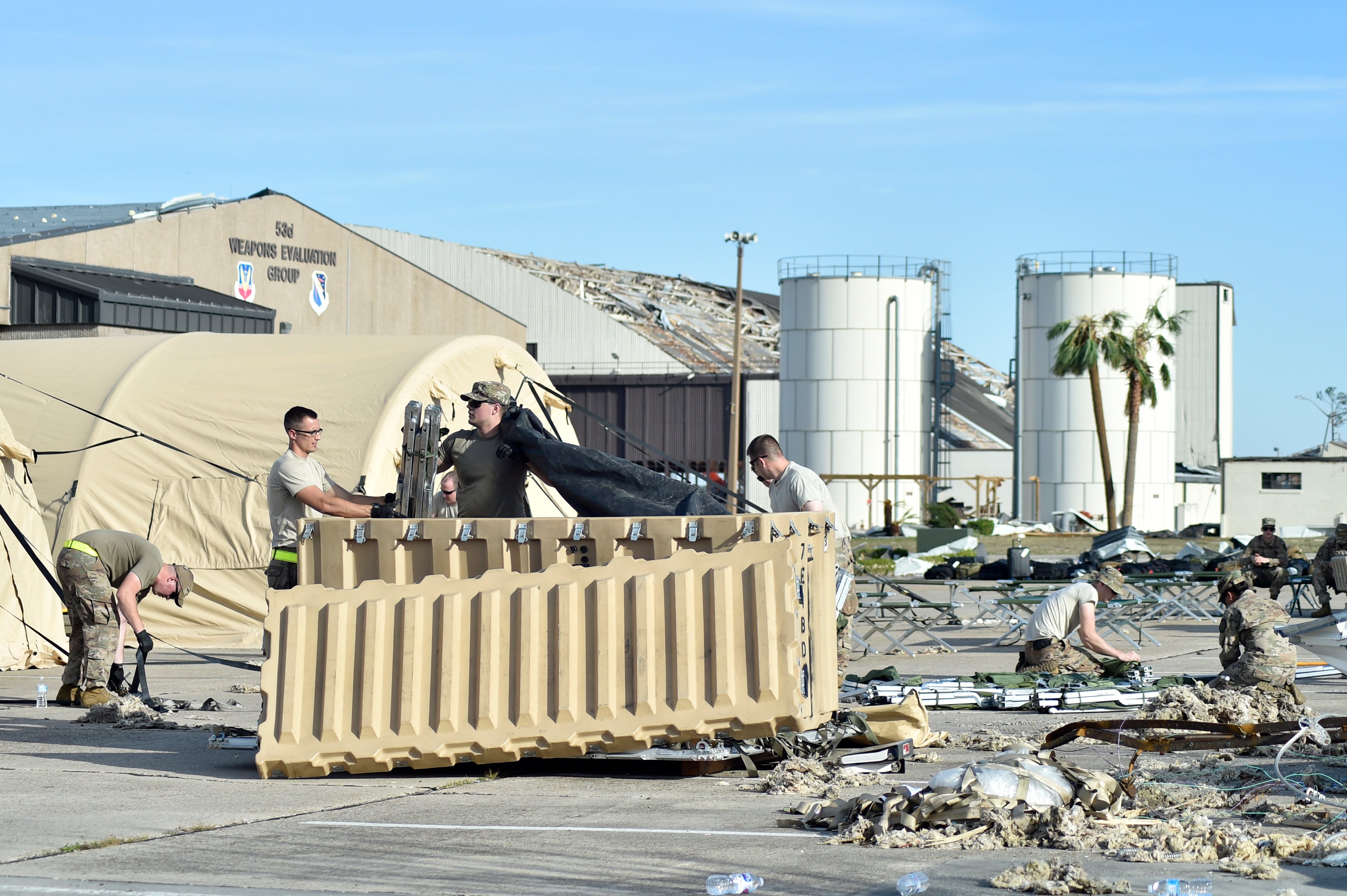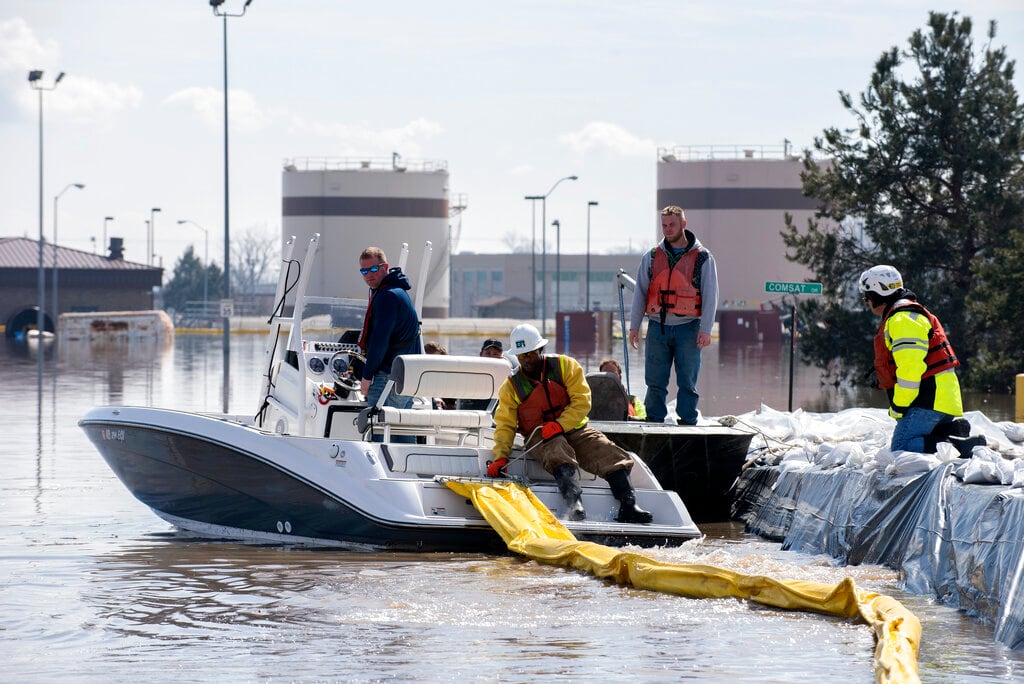TYNDALL AIR FORCE BASE, Fla., and WASHINGTON — In the months since Hurricane Michael hit Tyndall Air Force Base last fall, a sort of normalcy has returned. After an extensive cleanup effort, the base’s F-22 simulators are back in use. Unmanned QF-16s sweep across the sky, and F-22s make periodic showings in the airspace.
Base leadership told Defense News during a Feb. 25 visit that they are getting the funding they need for immediate requirements. But that could all stop May 1 unless Congress approves a supplemental funding bill.
Back in Washington, the Air Force has deferred 61 facility repairs at 18 other bases due to a lack of funding, and leaders are warning more slowdowns could follow if lawmakers don’t quickly approve a new cash infusion.
The situation is further complicated by devastating floods that battered Offutt Air Force Base, Nebraska, this month. The service now estimates it will need $1.2 billion in fiscal 2019 and $3.7 billion in fiscal 2020 and 2021 for recovery at Tyndall and Offutt.
“We desperately need the supplemental funding to recover from the natural disasters that hammered Tyndall and Offutt,” Air Force Secretary Heather Wilson said at the Heritage Foundation Wednesday.
"There are other decisions we’ll have to make if we don’t [have supplemental funding] by May or June. These are just the first decisions that we had to make yesterday … 61 projects in 18 states are not going to happen because we have not gotten a disaster supplemental for Tyndall.”
In the aftermath of Hurricane Michael, the Air Force has spent about $410 million on Tyndall, Wilson told reporters earlier this month. All of that has come out of the service’s fiscal 2019 operations and maintenance account — specifically the Facilities Sustainment, Restoration and Modernization account — meaning that the service is raiding funds meant for other projects that were set to start later this year.
“If we don’t get that supplemental, really by April of this year, we’re going to have to start deferring projects at other bases for facility modernization and ops maintenance stuff, because we’ve had to rob all these other accounts, and we still don’t have a supplemental,” Wilson said after a March 12 congressional hearing.
What could be on the chopping block if Congress can’t manage to pass a supplemental?
Aside from the work stoppage at Tyndall that would start in May, the Air Force would have to begin deferring aircraft repairs on May 15. This could throw a wrench into the Air Force’s plans to improve mission-capable rates for its aircraft — and especially the F-16, F-22 and F-35 fighters. Former Defense Secretary Jim Mattis last year ordered the Air Force to get those three air frames up to 80 percent mission-capable by the end of September 2019.
In July, a work stoppage for the recovery at Offutt would begin, “with the exception of immediate health and safety needs,” the service said. However, facilities would not be assessed, and damage mitigation efforts would be delayed. This could worsen the mold and water damage at Offutt’s flooded facilities.
RELATED

Finally, by September, five unspecified bombers would be grounded, and a backlog of maintenance for the E-3 airborne warning and control aircraft would begin, the Air Force said in a statement. At this point, about 18,000 flying hours would be cut from training, which would mean pilot readiness in the Air Force would take a hit.
At least for now, Tyndall is getting all of the funding it is asking for, Col. Brent Hyden, the program manager for Tyndall’s reconstruction, told Defense News in February.
However, he made clear that — at some point — other bases would be hurt by the funds diverted to Tyndall.
“The Air Force uses a construction tasking order for deciding how we do repairs worldwide, how we prioritize repairs and facility construction worldwide. We have been pulling off that to fund the Tyndall reconstruction,” Hyden said. “There are projects on the construction tasking order that may not get funded this year — for other bases — if there is no supplemental.”
The list of projects that are deferred, provided by the Air Force, includes facilities across the United States and at overseas bases.
Included in the 61 delayed projects are heating ventilation and air conditioning repairs or replacements at Buckley Air Force Base, Colorado, MacDill Air Force Base in Florida, Ramstein Air Base in Germany, Kunsan Air Base in South Korea, Tinker Air Force Base, Oklahoma, and Joint Base Charleston in South Carolina.
Other delayed projects include: runway repairs at Davis-Monthan Air Force Base, Arizona, and the Air Force Academy in Colorado Springs; dorm renovations at Barksdale Air Force Base, Louisiana, and Dyess Air Force Base, Texas; roof repairs at Joint Base Andrews in Maryland; renovations to a sensitive compartmented information facility at Dyess; and repairs to the academy’s iconic cadet chapel.
The Air Force last week unveiled a new long-term infrastructure strategy that it hopes will whittle down a $33 billion backlog in building repairs. It will raze its oldest, most dilapidated buildings (5 percent of the total) and concentrate spending on buildings that need preventive maintenance before they get worse. But even that effort could get sidetracked if the Air Force has to divert money to pay for disaster recovery.
A little help from Congress?
By the end of the FY19, Wilson estimates, the Air Force will need $750 million in O&M funds plus about $150 million in military construction money to start the planning for Tyndall’s reconstruction. Offutt will require $350 million to begin recovering the base.
The total bill for Tyndall’s reconstruction? The Air Force is still assessing exactly how it wants to rebuild the base, including what will be demolished and built anew, but lately officials have been saying anywhere from $4.5 billion to $5 billion.
As for Offutt, Wilson said the total price tag remains unknown.
“We haven’t even begun to estimate fully what the impact at Offutt is going to be,” Wilson said at Heritage.
But some immediate relief could be forthcoming.
The House in January passed one hurricane relief bill, sponsored by Rep. Nita Lowey, D-N.Y., who chairs the House Appropriations Committee. That legislation would provide $700 million in military construction funds and $400 million in O&M to the Air Force to address the damage caused by Hurricane Michael, and it was transferred to the Senate this month.
On Tuesday, Senate appropriators released a complementary version of the bill, which like Lowey’s legislation would provide a total $1.1 billion to Tyndall.
Local advocates for the base are hopeful that the Senate will take up hurricane relief legislation as early as this week.
“That would be a great start,” said Tom Neubauer, head of Bay County Alliance, a not-for-profit organization that is working with the Florida delegation to get supplemental funding for Tyndall.
“If we don’t get this money, there are going to be a lot of issues impacting readiness across the Air Force,” he said. “They’ve spent a lot of money and it could affect everything from flying hours to repair projects all across the enterprise. So we’re really concerned about that.”
Behind the scenes troubles
Getting additional funding has been a slow and often political process. The Office of Management and Budget has not approved a supplemental funding request, which certain lawmakers in the House wanted to see before moving forward on legislation, Neubauer said.
Wilson has maintained that Congress does not need a proposal from the administration to pass a supplemental, and another Air Force official told Defense News that the service has found other ways to convey its FY19 hurricane recovery funding requirements to Congress.
In a March 23 memo, Acting Secretary of Defense Pat Shanahan said that he would “work with Congress to enact a supplemental to cover hurricane, storm, and flooding recovery costs that the Department is not typically expected to absorb,” but it was unclear whether a request could be coming from OMB itself.
But in her increasingly public warnings about the current lack of disaster spending, Wilson says the consequences to the service could be dire, widespread — and imminent.
“This storm, if we don’t get a supplemental, is going to affect the rest of the Air Force and our ability to operate," Wilson said Wednesday. "We desperately need the supplemental to recover from the natural disasters that hammered Tyndall and Offutt.”
Rebecca Grant, a national security analyst at IRIS Independent Research, said the Air Force is trying to prevent a “mini sequestration.” She noted that there’s “always an additional cost” for when work has to stop and restart again later, but it’s also possible that this could have an even more longstanding detrimental impact to readiness.
“Does this put her readiness tasker at risk with the instructions to get certain airframes up to [an] 80 percent [mission capable rate]?" she said. "There have been a lot of discussions about how to meet readiness goals and still provide long-term readiness for those airframes. That comes to mind immediately.”
Valerie Insinna is Defense News' air warfare reporter. She previously worked the Navy/congressional beats for Defense Daily, which followed almost three years as a staff writer for National Defense Magazine. Prior to that, she worked as an editorial assistant for the Tokyo Shimbun’s Washington bureau.
Stephen Losey is the air warfare reporter for Defense News. He previously covered leadership and personnel issues at Air Force Times, and the Pentagon, special operations and air warfare at Military.com. He has traveled to the Middle East to cover U.S. Air Force operations.





